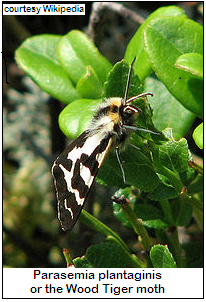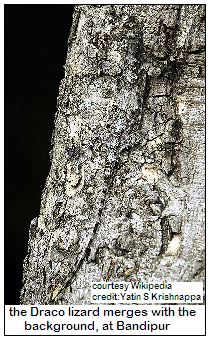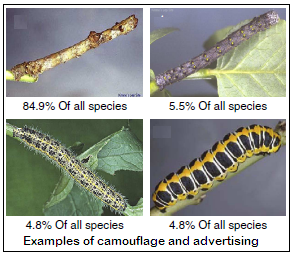Trim your sails to suit the wind is advice that that nature follows to keep out of trouble, says S.Ananthanarayanan.
During times when research keeps throwing up the counterintuitive and unexpected, it is good to find that a part of nature behaves entirely as one would think it should. A method that creatures use to signal that that they are not a pleasant target to attack may need to be turned around to suit the changes in the individuals that read the signal. A study of the way larvae of the Wood Tiger, a moth common in many parts of the world, adapt to circumstances shows that this is exactly the case.

Keeping out of harm's way
Perhaps the best way to keep out of trouble is not to be seen. A great many of the world’s creatures have evolved to merge with their surroundings and become difficult to see. Some do it so that they can better attack and capture their prey, a great many do it so that the predator cannot see them. The chameleon is one that is able to adapt its skin colour but many have evolved to disappear in different ways. The Draco lizard, shown in the picture, is one that is doing it very well! But there are times in the life of a creature when what is important is not to stay out of sight, but specifically to be seen. During the mating season, insects adopt the most striking patterns and colours, both to be easily spotted as well as to advertise that they are ready to mingle. It has its down side, no doubt, but now the priority is different.

There is yet another way to stay out of harm, and that is to be positively unattractive, as a meal. Some creatures have evolved to taste horrid, others to smell foul, and yet others are actually poisonous, or have a painful sting, which it is not worth the predator’s while to suffer. But it is not enough just to be avoidable, predators who are looking for food also need to know about it. Creatures thus use the opposite of camouflage – bright, striking colours, to advertise their detestable, but protective trait. The advertisement is then their primary defense, the fact that is advertised is the secondary. Examples of this kind of defense are the Granular Poison frog, which announces its noxious taste by bright red, or the Flamboyant cuttlefish, whose colours tell predators that it packs a painful sting, or the skunk, which is left well alone, because of the stink it can raise, and lets no one make a mistake, by its white and black body colour.

But predators do not naturally know about the message that the colours or other advertising gimmicks wish to pass. Predators stay away only after at least one unpleasant encounter, from which they learn that for all its colours, this tidbit is a no tasty mouthful. And hence behavior patterns - creatures that advertise unpleasantness generally move slowly, there is no need for speed, and in groups – in groups because a predator may attack one of the number, but will generally not come again and the rest are safe. They are also resistant to injury, so that an accidental attack need not kill them before the attacker has learnt better.
But the advertisement strategy is essentially risky, because it exposes the animal, in fact, calls for attention, and promises safety only provided that the predator knows that this species should be left alone. If there are many predators that are yet to receive the lesson, it may be better to stay out of sight. But staying camouflaged and hidden all the time has a cost and may be a disadvantage if the predator population already knows which insects to avoid – and there must be a condition when one strategy wins over the other. Johanna Mappes, Katja Ojal and Leena Lindstrom of the University of Jyvaskyla, Finland and Hanna Kokko of the Australian National University, Canberra report in Nature Communications their study of 688 caterpillar species and their rates of survival during the season of growth of predator birds. They find that the strategy of advertising is safer at the beginning of the season, when newly hatched birds are still in the nest, or at the end of the season, when there are no fledglings, but staying hidden is the safer way when young birds have just taken to wing and make a dash for every brightly coloured caterpillar they see.

The study showed that early in the season and again late in the season, it was the warning colours that were more effective at promoting survival, than the black colour camouflage. These are the periods when there are less newly arrived birds and the predators are all educated about staying away. But in the middle of the season, when newbies are out in numbers, advertising invited attack and it was camouflage that ensured the best survival. The survival rate of the completely black larvae increased and peaked, to exceed that of the coloured species, at the middle of the season. And this pattern matched the data on fledgling times of the birds which were the main predators. But the survival of coloured species rose again towards the end of the season, which corresponds to ‘declining naiveté’ of the predators.
Even in normal times, it seems colouration cannot be a widely preferred strategy as there would always be a few uninitiated adults or a particularly hungry predator. The dynamics of how the use of one strategy or the other is chosen are also affected by another factor - the fake advertising by foreign species, to piggyback on the protection that some bright colours confer. This is a behavior used by many harmless insects and reptiles, to ‘pass off’ as something dangerous, both for protection as well as for easy passage. When these instances grow in number, they are likely to be victims of accidental strikes – which would cause powerful unlearning of any lesson the predator had earlier received, or a wrong learning by a novice predator. The protection conferred by colouring would then weaken and the fakes would get rapidly reduced in number, which would restore the value of colouring, and so on.